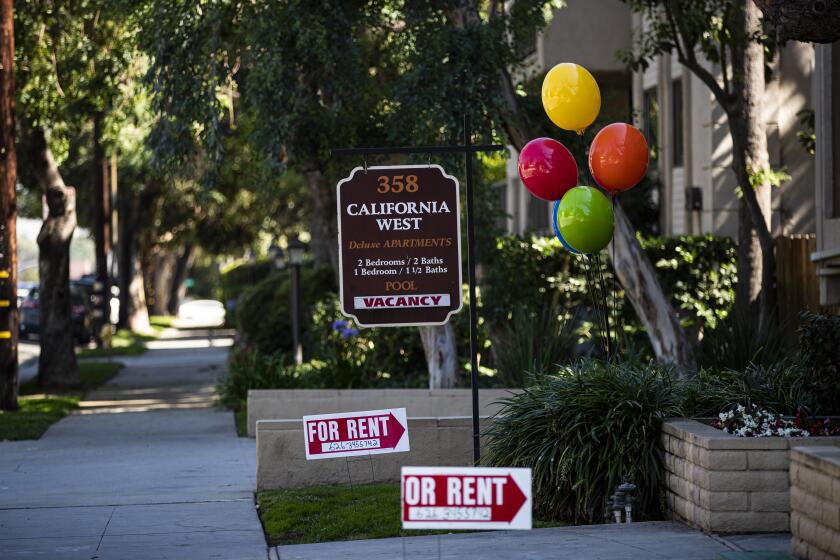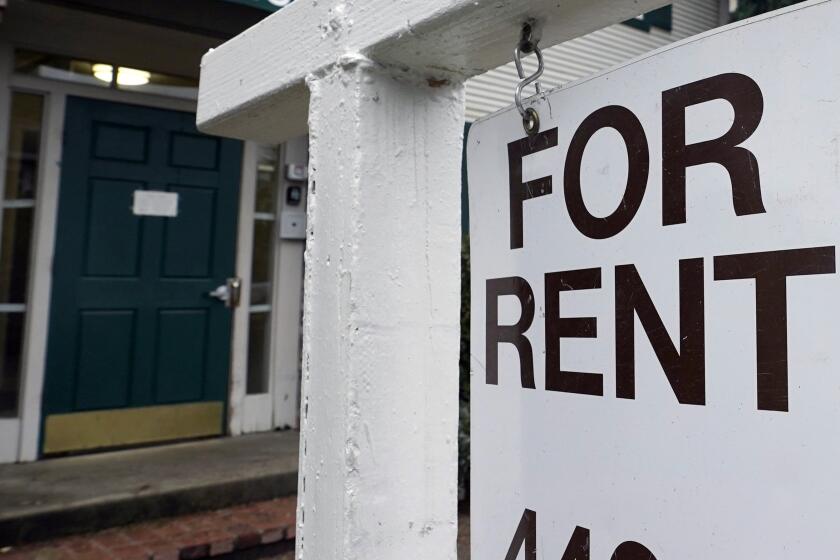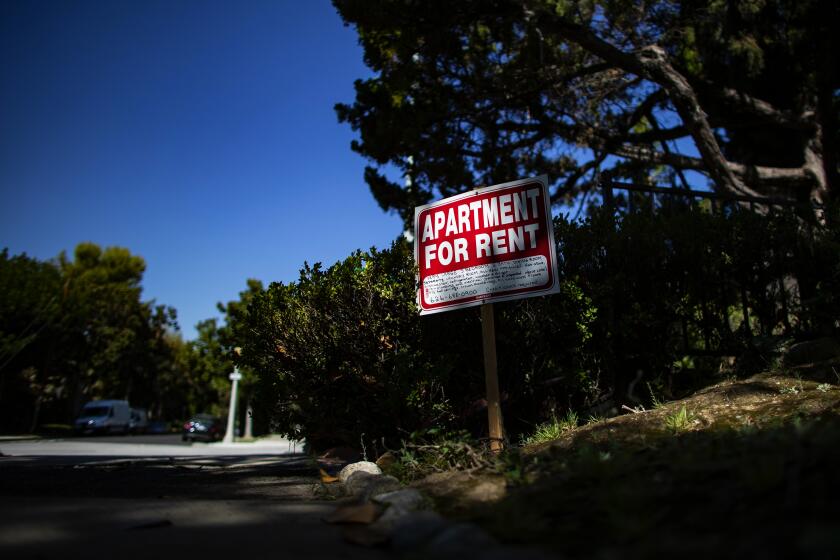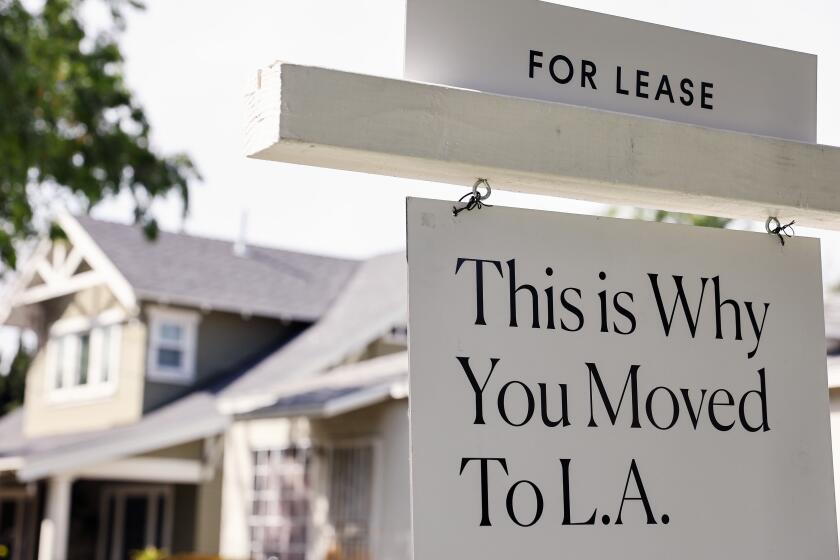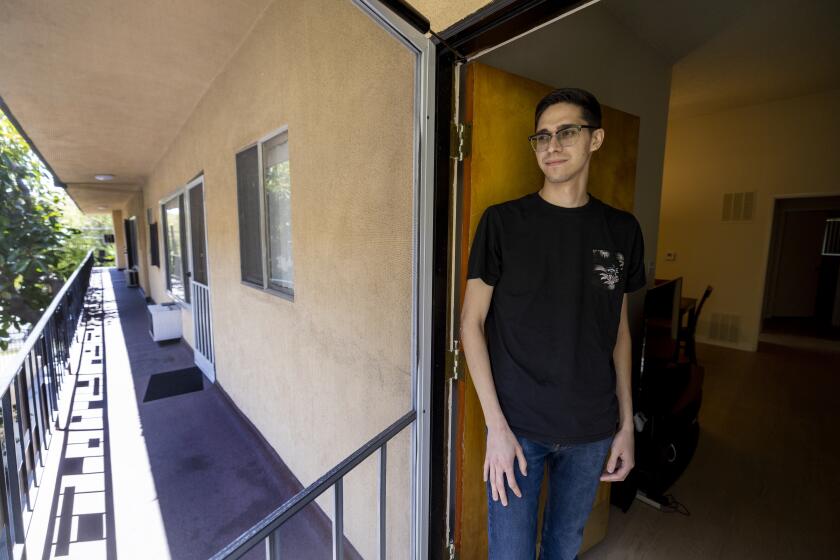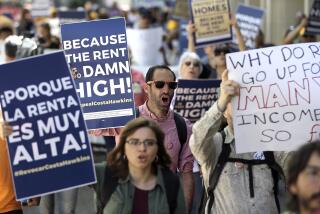More California cities enact rent control to protect tenants, upsetting apartment owners

- Share via
When Bell Gardens resident Monchis Curiel got a notice last year from her landlord that rent for her three-bedroom apartment would more than double the next day — from $1,200 a month to $2,500 — she was shocked.
Curiel, 47, has lived in the city for more than three decades and knew her landlord was required to give at least 60 days’ notice for such a large increase. She decided to fight the move in court and won. And because her landlord didn’t want to pay the relocation fees under Los Angeles County’s rent stabilization ordinance, Curiel was offered a one-year lease at her original rent.
Curiel, a single mother of four who earns about $14,000 annually, said that if she hadn’t known her rights as a tenant, she would’ve been forced to move out.
“I would’ve separated my kids from my family. They would’ve gone to their father, and I would probably be sleeping in a car,” she said. “What I cared about is that my kids had a roof.”
Does your apartment have rent control? Does the rental you want to move to have it? Here’s how to find out in Southern California.
After fighting her eviction, Curiel joined tenant advocates seeking a rent control law in Bell Gardens. On Aug. 22, the City Council voted unanimously to advance a rent stabilization ordinance that would limit annual rent increases to 50% of the local consumer price index, capping the hike at 4% even if the inflation rate is higher.
Rent control has long been a tool to protect people from being priced out of their homes. But with California’s rents rising amid a hot real estate market, more cities are turning to the protections. This has won praise from tenant groups and opposition from apartment owners’ organizations, which have been critical of the Bell Gardens plan.
Last week, the Antioch City Council passed a similar rent control ordinance that caps annual rent increases in the Bay Area city at 60% of the CPI or 3% — whichever is less. On Aug. 1, Pomona’s City Council set a rent cap at 4% or the change in CPI.
Santa Ana adopted a rent control ordinance in November, limiting increases to 3% per year or 80% of the change in the CPI. The city of Oxnard capped rent increases at 4% per year in April. And in November, Pasadena residents will vote on their own rent control measure.
Starting Monday, California landlords are allowed to begin raising rents under a 2019 state law.
Some California landlords were allowed to bump their rent starting Aug. 1 by as much as 10%, the maximum annual increase under Assembly Bill 1482, a statewide law passed three years ago. But the 10% cap applies only to complexes built before 2007 and those not subjected to rent control restrictions, meaning that other landlords can raise their rents even higher.
Cities and counties across California have also passed local ordinances protecting against no-fault evictions. AB 1482 protects tenants who have lived in their apartments for at least a year.
Bell Gardens City Manager Michael O’Kelly said the city’s ordinance needs a final vote, scheduled for Sept. 12. If approved, it would take effect 30 days later.
“Rents in [Bell Gardens] and throughout Los Angeles County continue to rise, and although the city has lower rents relative to surrounding communities, many local residents — particularly low-income households — struggle with paying for rising housing costs and meeting other basic needs such as food, transportation and healthcare,” he said.
Lupe Arreola, executive director for Tenants Together, a statewide renter advocacy group, said that according to the latest U.S. Census data, about 44% of California renters are spending more than a third of their income on rent. She also noted that about 75% of single mothers and 64% of single fathers are renters.
“When you have a single parent raising an entire family on one income, any increase in expenses could be destabilizing and also could mean the difference between the wealth being in the family [or it] could mean eviction,” she said.
Arreola said increasing rents are not keeping up with wages, which could lead to evictions and “irreparable harm.”
“It’s not just an economic issue but definitely one that has to do with equity and community safety and health, and makes it so that children are at the center of the decisions our community makes,” she said.
Data collected by the U.S. Bureau of Labor Statistics -- but not made available to the public -- show a gulf between the market conditions affecting new versus renewing renters.
About 78% of Bell Gardens’ residents are renters, according to data from the Southern California Assn. of Governments. And about 64% of households in the city spend 30% or more of their gross income on rent.
Among those living in Bell Gardens, about 96% are Latino and at least 26% of the population is in poverty, according to U.S. Census Bureau data.
“Even pre-COVID and pre-inflation, people were having trouble paying their rent,” said Susy Herrera, communications director for California Latinas for Reproductive Justice, one of the groups fighting for rent control in Bell Gardens. “People were definitely working multiple jobs, and COVID really exacerbated that.”
Herrera said through the group’s organizing efforts, she’s heard from people who hope rent control will be implemented in their cities.
Not everyone is in favor of the control measures.
Daniel Yukelson, executive director of the Apartment Assn. of Greater Los Angeles, opposes all forms of rent control and said the Bell Gardens ordinance “went well beyond anything even close to ‘fair and balanced.’ ”
“On the heels of moratoriums on evictions and challenged rent collections over the past two-plus years, and now unprecedented inflationary pressures, property owners will never be able to keep up and will leave the business,” he said.
Yukelson said rent control laws also could hurt tenants by locking them into rent-stabilized units.
“They are less likely to give up their below-market rental unit to purchase property of their own, to take a better job opportunity out of the area, and they often stay in place long after the usefulness of their rental unit has ended,” he said.
California renters hate paying application fees when looking for apartments. Legislation to allow reusable credit reports has passed the state Senate.
California’s first experiences with rent control began during World War II amid low vacancy rates and the slowdown of construction in the aftermath of the Great Depression. The Emergency Price Control Act of 1942 controlled the prices of goods and services, including rent.
The statute was phased out a few years later, and California saw an uptick in tenant advocates during the 1970s, another period when inflation was high. More than a dozen cities have some type of rent control, including Los Angeles, Inglewood, Palm Springs, Santa Monica, Beverly Hills, West Hollywood, San Francisco, Alameda, Berkeley, Hayward, East Palo Alto, San Jose and Los Gatos, but tenant advocates say they still experience rent increases.
Santa Monica, for example, was one of the first California cities to adopt rent control in 1979, but Santa Monica Rent Control Board member Anastasia Foster said laws across the state have been hampered by the 1995 Costa-Hawkins Rental Housing Act. It bars rent control on condos, single-family homes and buildings constructed after 1995, and prohibits “vacancy control,” allowing landlords to raise the rent to any price for a new tenant after the previous one has moved out.
Foster pushed back on the notion that landlords won’t see enough return on their investments because of rent control laws.
“Even if there’s a pinched year or moment in time for the entire economy, which includes landlords, the effect felt is not the same,” she said. “There are tenants who have to make decisions between paying for groceries or for medication. I don’t think buildings worth millions of dollars are the same level of risk as our tenants.”
In November, Santa Monica voters will decide whether to tighten their rent control rules to limit increases to no more than 3% a year. Under current regulations, tenants can receive a 6% increase.
The spate of recent local rent control measures runs counter to failures to expand the policy statewide. California voters twice rejected initiatives to expand rent control by nearly 20 percentage points in 2018 and 2020 after $100-million-plus campaigns in which landlord groups outspent supporters of the initiative by more than 2 to 1.
The number of apartments available for rent in L.A. County is the lowest it’s been in two decades. The booming job market isn’t helping.
A nationwide eviction ban was implemented during the pandemic in 2020 to prevent millions of evicted tenants from potentially spreading the coronavirus when they had to move out. The Supreme Court rejected a challenge by landlords in June 2021 to lift the federal eviction moratorium but allowed the protections to expire in August 2021 by blocking President Biden from extending it for two months.
Curiel said she started working with Unión de Vecinas de Bell Gardens, a community group associated with California Latinas for Reproductive Justice, to try to pass rent control in the city so no other renter has to endure what she went through.
“This has changed the city of Bell Gardens,” she said. “It’s history. In none of these years that I lived here was anything ever done for us tenants until we picked up our voices and united. We accomplished this big victory.”
Times staff writer Liam Dillon contributed to this report.
More to Read
Sign up for Essential California
The most important California stories and recommendations in your inbox every morning.
You may occasionally receive promotional content from the Los Angeles Times.
